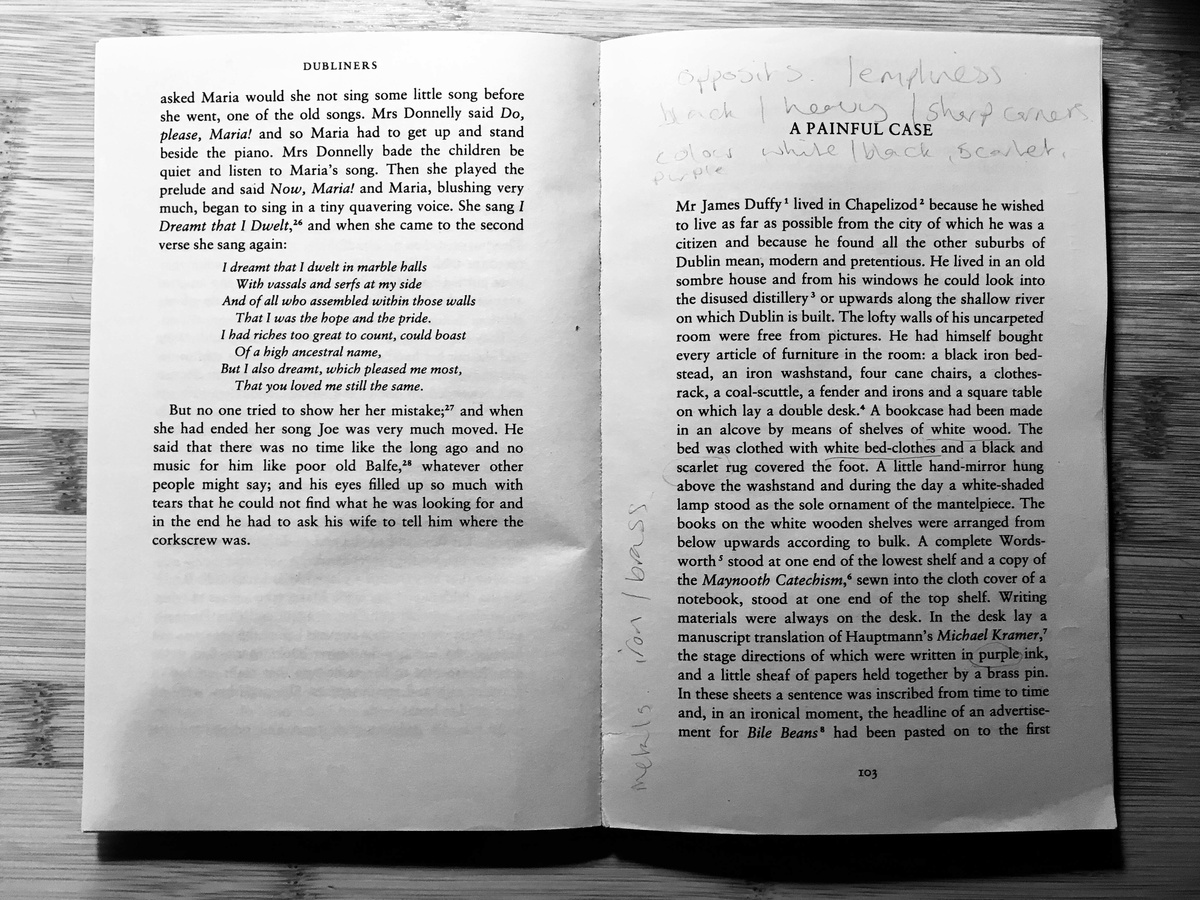a conversation – ‘A Painful Case’ / James Joyce
This is an account of a series of telephone conversations that Jeni had with a patient we will call ‘M’ in March 2020, just as the country went into a national lockdown due to the Coronavirus Pandemic.
A bit of background:
We had talked about the writing of James Joyce many times during the art sessions. English literature was the subject that M had studied and taught in his professional life, and literature was almost always the starting point and influence for the art work he made while in the art room. As Artists it was a chance for us to learn about books and poems in a more in depth way and a challenge for us to help bridge the links between the words and the visual aesthetics of the piece M created. This was achieved through a rich two and fro of dialogue involving ideas, aesthetics and technical considerations.
At the beginning of March the art team moved from our beloved art room in the hospice to working remotely from home. M was on my list of people to contact.
The first phone call:
M was tired, just out of hospital, living alone and had no access to the internet. His family lived abroad. He was struggling to come to terms with the news that his disease had progressed, the prospect of lockdown and how this would shape his experience of living and possibly dying in amongst a global pandemic.
Initially it was difficult for him to think of ways he could continue to be creative with the enormity of the situation ahead, so instead we focused on smaller things. We talked about the books we were reading and how helpful it was to know that reading continued to be something we could enjoy.
Reading would open up our world again and let us go safely to places that we were no longer able to go. We decided during this call that we would try our best to keep reading and it would help us through this difficult time and that we could use it to form the basis of our future creative conversations. It could be a book, a poem, a chapter, a verse, a page, a paragraph or a sentence.
In the past we had briefly talked about a short story called ‘A Painful Case’ by James Joyce and during our phone call we agreed that we would both read it again and use it as a starting point for our next telephone conversation.
And then:
When we spoke again the following week M was more upbeat, happy to talk and lead on subjects that were of interest. Instead of simply discussing the story we explored the themes in relation to the present situation of social distancing and the importance of making human connections with others.
In the story, solitude triumphs over human relations. We talked about passages of descriptive text that observe the main protagonist’s inability to have empathy or to be influenced by others, and how the story is almost a warning of what can happen if you lose the ability to make meaningful human connections.
There were also aspects of the writing that mirrored the more technical parts of M’s art practice that had been recurring and challenging for him over a period of time. Scenes build up in Joyce’s story, layered with black, white and grey imagery. We reflected on how M initially struggled to bring light into his drawings and paintings and his apprehension “to go too dark”, and then our subsequent conviction that to see the light you have to go to the dark.
Based on these initial conversations about the tonal qualities of a piece of work, M first suggested that I read ‘A Painful Case’ which is interesting in its self. It suggests that what M could not understand in a visual sense, he was able to comprehend through the words of James Joyce.
It takes time to build trust with the people we work with and it often requires an ability to adjust your practice to the person you are supporting, and also to understand that this is likely to change as a person becomes less well.
M and I were making progress. Things were limited, but the creativity and the meaning was not lost. M, like the other people on my list of calls to make, appreciated the call and the nature and breadth of the conversations. Unfortunately, these creative sessions had to stop when the art team were furloughed at the end of March. I am so curious to know what they could have led to. Our conversations were so full of possibility.
And now:
Being on furlough means we have no way of knowing if M will be there when we are able to return to work. Sadly, given his prognosis I think he will not. For the art team it feels like missed opportunities and it has left us wondering what this experience has been like for people living with life-limiting illness.
Whilst we truly understand the need to be physically distant to keep people safe, it doesn’t have to mean that we become socially distant. There are many ways that we can form rich and creative relationships with people. We are living in a time where people, especially those that are shielding, need this now more than ever before.
